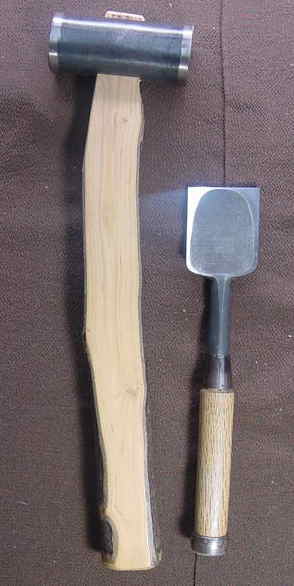| Home > Technique & Knowledge > On Handle Materials: For Chisels and Gennous |
| White oak | The best handle material considering the cost effectiveness. It is lowest in price, yet it looks nice, and very robust and tenacious. The tenacity absorbs the shock when struck. Almighty wood for daily use tools. If there is one drawback it gets very dirty if you don't take care of it properly. When you sharpen you need to protect the handle not to get wet, if you don't want it to be dyed black from the steel particles, or purple from the ferrules dyed colour. |
| Red oak | Good red oak's red colour is very appealing. But I hear there are handles that are dyed to darker colour to make it look like good dark coloured red oak. These, when rubbed with thinner or lacquer remover, the stain comes off and the original light colour cheap red oak will be revealed, so you have to be careful. Some shops seem to think that people won't notice the difference and sell these kind of tools, unfortunately. Red oak is just a little softer compared to other handle materials, so it absorbs the shock very well, but at the same time the handle gets shorter quicker. |
| Boxwood | One of the most prized handle material which is becoming rarer and rarer. The tree itself is very small tree often used for hedges for traditional Japanese houses, so it is hard to get large amount of material from one tree. The colour is creamy yellow with beautiful fluid woodgrain. Often used for most expensive decorative chisels such as Ichihiro chisels. It is the hardest material used for nomi handle, so the feel (as well as the shock) comes more straight to your hand. Some consider it purely ornamental handle, and some consider it the most practical handle that carries the information of the cut the most. |
| Gumi | THE most prized and the rarest handle material for oiire chisels and hammer handles (see photos*). Good ones are nearly gone so you have to be careful when ordering with this material. Make sure with the seller that it is genuine Japanese Gumi. The tree is a small fruit tree, similar to quince, very tenacious almost impossible to break. The colour is similar to Boxwood, but there are more small knots. The ultimate connoisseur's handle material. |
| Ebony | Usually the streaky ones from Papua New Ginea, not the pitch black ones from South Africa. Very sticky and clayish kind of texture. Absorbs the shock fairly well. Goes well with polished finish chisels, because of the contrasting colour. |
| Rosewood | Beautiful purplish brown. Similar to ebony in texture but a bit more dry feel. Again good for polishied finish chisels. |
*The hammer (genno) shown below is Hasegawa Kouzaburou, chisel next to
it is Hidari Ichihiro. Both considered to be the best out of each tools.
Kouzaburou genno has Gumi handle attatched with the bark on to keep the natural beauty
of the tree, and as an antislip. Of course it is possible to make it into
normal smooth handle as well. Japanese hammerheads have two different striking
surfaces on each sides. One flat (koguchi-men) and another slightly convexed (kigoroshi-men) to drive
in the nail head with the last couple of taps. The bent handle makes it
possible to know which side is which without checking. The difference is
slight so, it is quite frustrating if you have to check everytime you put
down the hammer.
A bit more on Japanese hammers, since I started (^^). Top quality handmade
Japanese hammerheads are not hardened just evenly throughout the body. The
hardness is different within a single head. The centre of the striking surface
is softer so that it won't be as slippery when striking the nail. The peripheral
is made harder to prevent dents and chips. The body is hardened and tempered
to make it as tenacious as possible to absorb the shock. The best of the
best hammerheads are constructed using soft iron for the body and steel
laminated on the striking surface. The MOST expensive ones even have wood
grain pattern on the jigane (body iron). The handle attatching hole is opened
to absolute square, and the center is made slightly tighter by tapping the
body from outside after the hole has been gouged. This makes it possible
for the handle to be attatched with no wedge holding the handle from the
other side, and still will not come off. The best made hole's edge is not
rounded at all, and it looks as if it was chiseled out.
Japanese gennous aren't just a chunk of steel with a hole in the middle.
It has a microcosm in itself.
